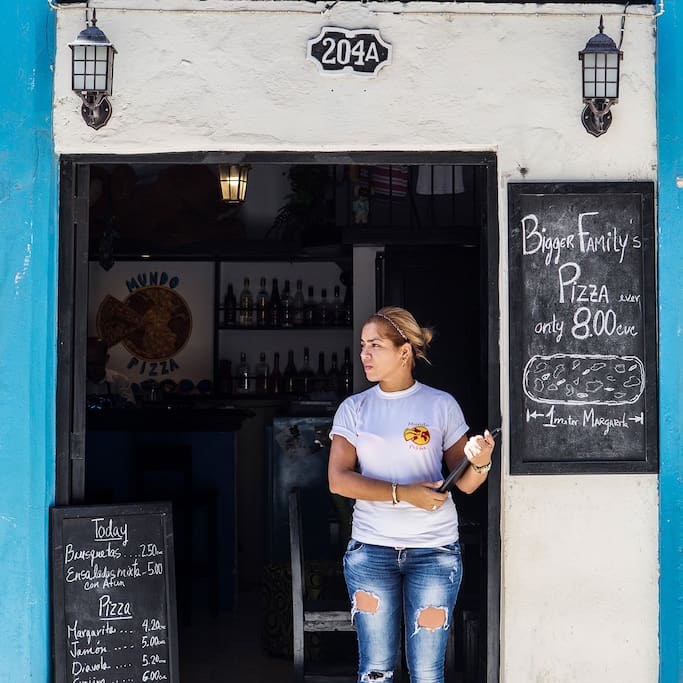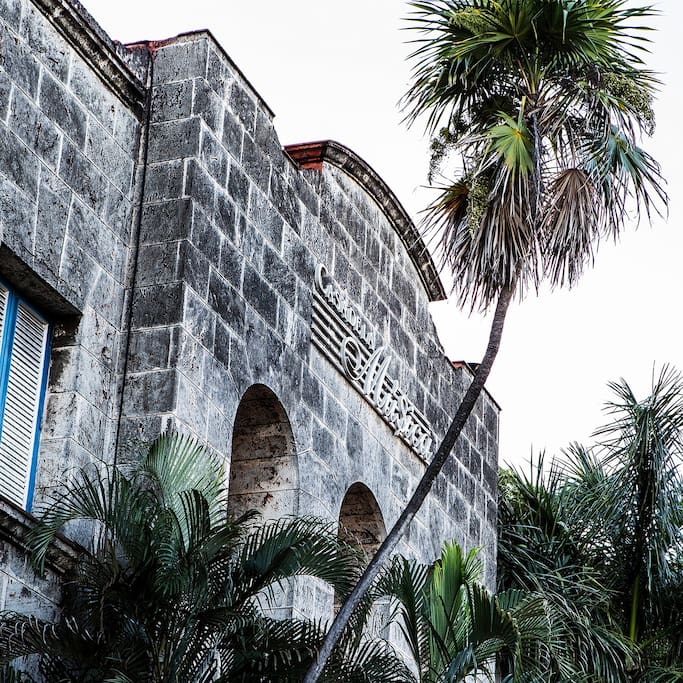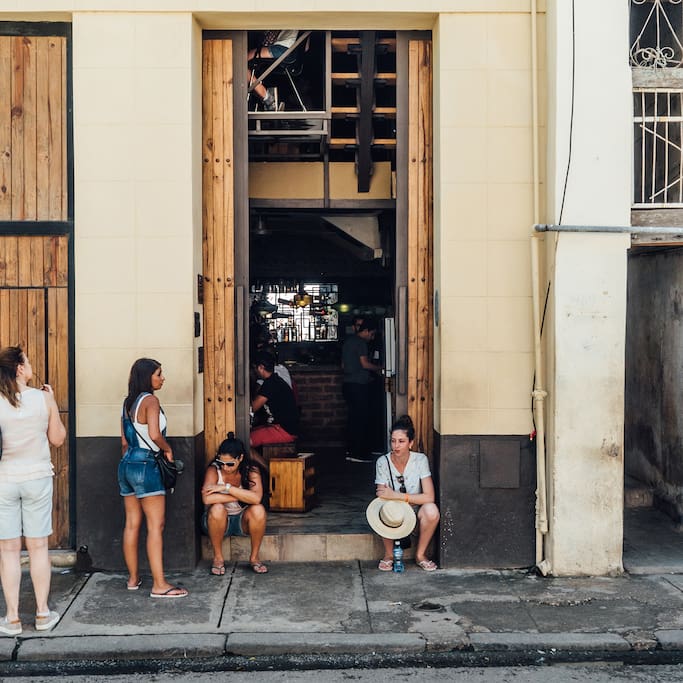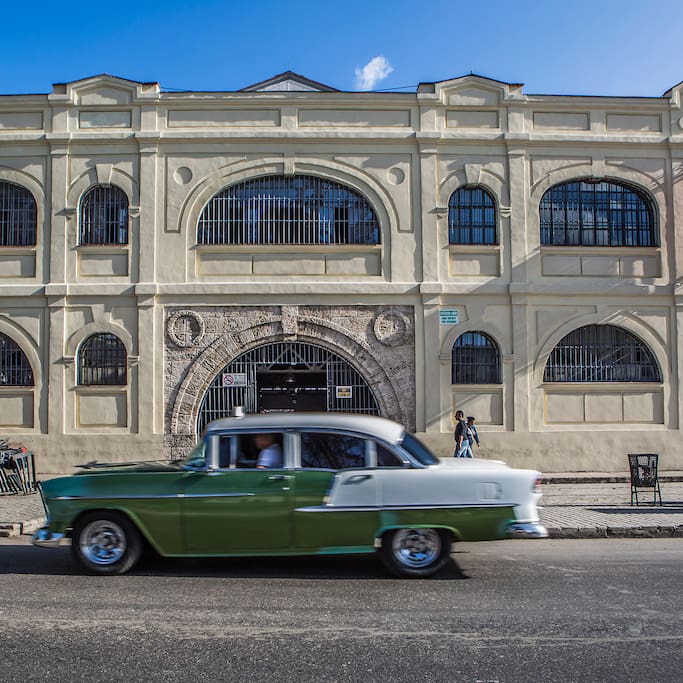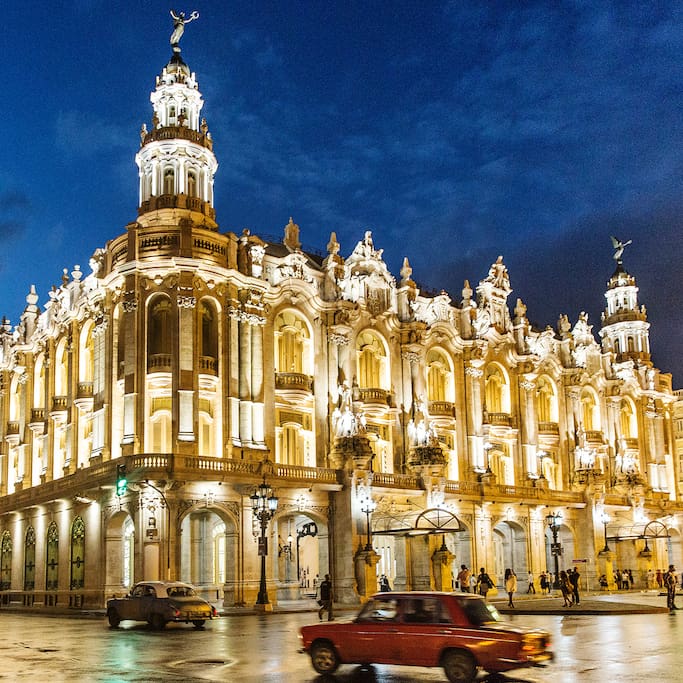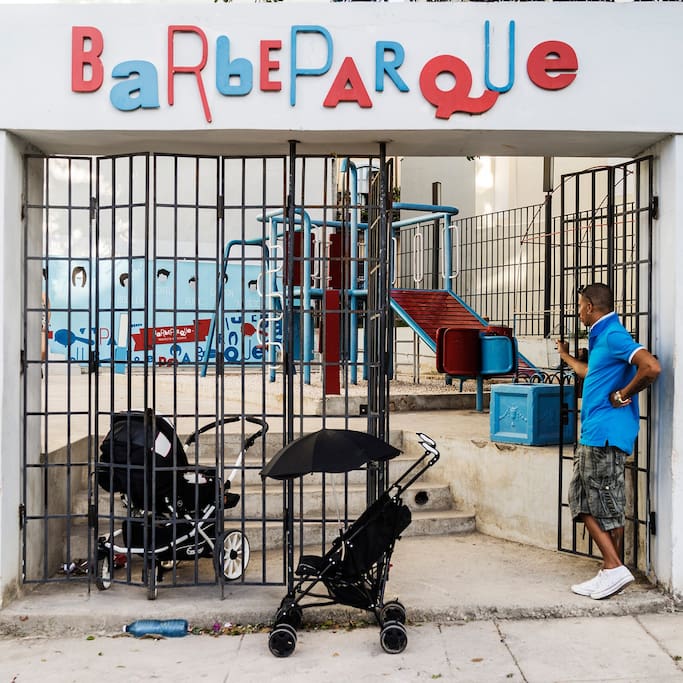Food Scene
This place makes us travel to the past: in vitrolas, hanging bicycles, images from other eras call for thousands of sensations while tasting the delights from the kitchen. In one of the corners of the Old Square La Vitrola delights with its sounds from well into the morning, with its tasty breakfasts, until midnight. The memory and the flavor in a corner of Old Havana.
155 ντόπιοι το προτείνουν
La Vitrola
San IgnacioThis place makes us travel to the past: in vitrolas, hanging bicycles, images from other eras call for thousands of sensations while tasting the delights from the kitchen. In one of the corners of the Old Square La Vitrola delights with its sounds from well into the morning, with its tasty breakfasts, until midnight. The memory and the flavor in a corner of Old Havana.
La Bodeguita del Medio is a typical Havana restaurant in Cuba, one of the great tourist places of the city, where many visitors have passed, from writers to politicians. All of them leave their mark on the premises by means of some memory, photos, objects or graffiti on their walls. In them you can find copies of signatures as unusual as Errol Flynn and some originals like Salvador Allende.
In its rooms you can enjoy the typical Cuban atmosphere, with its gastronomy, its cigars and its music; that collect all the essence of tradition.
743 ντόπιοι το προτείνουν
La Bodeguita Del Medio
EmpedradoLa Bodeguita del Medio is a typical Havana restaurant in Cuba, one of the great tourist places of the city, where many visitors have passed, from writers to politicians. All of them leave their mark on the premises by means of some memory, photos, objects or graffiti on their walls. In them you can find copies of signatures as unusual as Errol Flynn and some originals like Salvador Allende.
In its rooms you can enjoy the typical Cuban atmosphere, with its gastronomy, its cigars and its music; that collect all the essence of tradition.
Spanish still life and in the light of lanterns and candles, the customer can enjoy in Los Nardos exquisite preparations in the more than 60 dishes included in the menu. From soup, paella, fish, seafood and other meats, all with two side dishes that includes the price. While the dinner is going on, it is possible to listen live to the chords of a piano, a violin or a flute, and as if that were not enough, with a cava of more than 500 bottles it is also possible to enjoy typical Cuban drinks and cocktails. international.
357 ντόπιοι το προτείνουν
Los Nardos
Paseo de MartíSpanish still life and in the light of lanterns and candles, the customer can enjoy in Los Nardos exquisite preparations in the more than 60 dishes included in the menu. From soup, paella, fish, seafood and other meats, all with two side dishes that includes the price. While the dinner is going on, it is possible to listen live to the chords of a piano, a violin or a flute, and as if that were not enough, with a cava of more than 500 bottles it is also possible to enjoy typical Cuban drinks and cocktails. international.
Those who love fusion cuisine and good cocktails have a date at the ChaChaChá bar and restaurant on Calle Monserrate, one of the most important communication arteries in Old Havana.
This establishment combines the decadent glamor of Cuba of the 40s and 50s with the most modern European avant-garde.
Located in the emblematic venue of the thirties, the ChaChaChá currently moves to the rhythm of salsa, funk, soul and Latin jazz.
The ChaChaChá consists of a restaurant area and a bar area, as well as a stage where authentic Cuban bands and soloists perform, and other renowned musicians from the international scene. Of course, there is not a big dance floor missing.
52 ντόπιοι το προτείνουν
ChaChaChá Bar-Restaurante
Those who love fusion cuisine and good cocktails have a date at the ChaChaChá bar and restaurant on Calle Monserrate, one of the most important communication arteries in Old Havana.
This establishment combines the decadent glamor of Cuba of the 40s and 50s with the most modern European avant-garde.
Located in the emblematic venue of the thirties, the ChaChaChá currently moves to the rhythm of salsa, funk, soul and Latin jazz.
The ChaChaChá consists of a restaurant area and a bar area, as well as a stage where authentic Cuban bands and soloists perform, and other renowned musicians from the international scene. Of course, there is not a big dance floor missing.
Sightseeing
The Cathedral of the Virgin Mary of the Immaculate Conception of Havana, is a Catholic temple, located in the heart of Old Havana, in the oldest area of the city, declared by UNESCO in 1982 a World Heritage Site.
It is the Cathedral of the Archdiocese of Havana, and its previous location was located where later the Palace of the General Captains was built.
175 ντόπιοι το προτείνουν
La Catedral de la Virgen María de la Concepción Inmaculada de La Habana
156 EmpedradoThe Cathedral of the Virgin Mary of the Immaculate Conception of Havana, is a Catholic temple, located in the heart of Old Havana, in the oldest area of the city, declared by UNESCO in 1982 a World Heritage Site.
It is the Cathedral of the Archdiocese of Havana, and its previous location was located where later the Palace of the General Captains was built.
The castle of the Three Kings, also known as Castillo del Morro, is the symbol together with the Capitol and the Giraldilla of Havana, drawn by the engineer Juan Bautista Antonelli in 1585 during the Spanish imperial period, its strategic position on a hill was recognized almost as soon as the port of Havana began to acquire the strategic importance it had in the Spanish overseas province.
Since then, the Morro Castle has maintained an active life, its halls function as a gallery and in its spaces an animated cultural life never ceases. In turn two restaurants (The Twelve Apostles and The Divine Shepherdess) and a bar are housed in their old batteries with extraordinary views of the Havana.
566 ντόπιοι το προτείνουν
Κάστρο των Τριών Βασιλέων του Μόρρο
The castle of the Three Kings, also known as Castillo del Morro, is the symbol together with the Capitol and the Giraldilla of Havana, drawn by the engineer Juan Bautista Antonelli in 1585 during the Spanish imperial period, its strategic position on a hill was recognized almost as soon as the port of Havana began to acquire the strategic importance it had in the Spanish overseas province.
Since then, the Morro Castle has maintained an active life, its halls function as a gallery and in its spaces an animated cultural life never ceases. In turn two restaurants (The Twelve Apostles and The Divine Shepherdess) and a bar are housed in their old batteries with extraordinary views of the Havana.
The leafy Parque de la Fraternidad Americana is located between Máximo Gómez and Dragones streets, at the southern end of Paseo del Prado.
Place where you will discover the daily life of the Cuban and surrounded by historical monuments next to it you will find the majestic Capitol
During the seventeenth and eighteenth centuries, the space was known as Campo de Marte and was intended for military and training exercises.
52 ντόπιοι το προτείνουν
Parque De La Fuente De La India
The leafy Parque de la Fraternidad Americana is located between Máximo Gómez and Dragones streets, at the southern end of Paseo del Prado.
Place where you will discover the daily life of the Cuban and surrounded by historical monuments next to it you will find the majestic Capitol
During the seventeenth and eighteenth centuries, the space was known as Campo de Marte and was intended for military and training exercises.
Built in 1519, shortly after the founding of the city, the Plaza de Armas is the oldest and one of the most beautiful in Havana, and at the time of the colony was its administrative center.
Stage of all kinds of celebrations (bullfights, autos de fe, executions, theatrical performances, royal parties, tournaments, canonizations and proclamations, etc.), has changed its name several times. Formerly it was known as Plaza de la Iglesia, for housing the Parroquia Mayor, the first church in Havana.
228 ντόπιοι το προτείνουν
Πλατεία των Όπλων
Built in 1519, shortly after the founding of the city, the Plaza de Armas is the oldest and one of the most beautiful in Havana, and at the time of the colony was its administrative center.
Stage of all kinds of celebrations (bullfights, autos de fe, executions, theatrical performances, royal parties, tournaments, canonizations and proclamations, etc.), has changed its name several times. Formerly it was known as Plaza de la Iglesia, for housing the Parroquia Mayor, the first church in Havana.
Originally an armory founded in 1934, under the name of Compañía Armera de Cuba, the place is since 1971 the Museo Armería 9 de Abril, a space dedicated to preserve and exhibit weapons.
The collection is composed mainly of offensive and defensive weapons and supplies related to them from the eighteenth century to the twentieth century, in addition to various objects that provide additional information. All this is distributed in two rooms and is ordered according to chronological criteria.
7 ντόπιοι το προτείνουν
Armory April 9 Museum
157 MercaderesOriginally an armory founded in 1934, under the name of Compañía Armera de Cuba, the place is since 1971 the Museo Armería 9 de Abril, a space dedicated to preserve and exhibit weapons.
The collection is composed mainly of offensive and defensive weapons and supplies related to them from the eighteenth century to the twentieth century, in addition to various objects that provide additional information. All this is distributed in two rooms and is ordered according to chronological criteria.
El Templete is one of those places of the past that seems to lie that they have survived the challenges of progress, one of those gifts that the urban planning of Havana offers us from time to time, dotted all over the city map. A site that reminds us because the capital of Cuba does not belong to the real world, it is a point and a part of everything.
This tiny Doric chapel was erected in 1828 on the east side of the Plaza de Armas, just opposite the former Palace of the Captains General, in the place where the first Mass in Havana was celebrated under the shade of a ceiba tree in November. of 1519.
26 ντόπιοι το προτείνουν
Rstaurant "El Templete"
BarilloEl Templete is one of those places of the past that seems to lie that they have survived the challenges of progress, one of those gifts that the urban planning of Havana offers us from time to time, dotted all over the city map. A site that reminds us because the capital of Cuba does not belong to the real world, it is a point and a part of everything.
This tiny Doric chapel was erected in 1828 on the east side of the Plaza de Armas, just opposite the former Palace of the Captains General, in the place where the first Mass in Havana was celebrated under the shade of a ceiba tree in November. of 1519.
Even without any artifact to display, the Museum of the City of Havana would remain an unmissable visit, courtesy of the opulent Palace in which it resides.
The Palace of the Captains General is the most important building of the Plaza de Armas and one of the most representative works of baroque architecture in Latin America. It dates from the 1770s and is a manual of Cuban Baroque architecture, carved in rock extracted from the nearby San Lázaro quarries.
Occupying the entire west side of the plaza, the palace stands on the site of the demolished Parroquia Mayor, the first church in Havana.
116 ντόπιοι το προτείνουν
Palacio De Los Capitanes Generales
Cuba TacónEven without any artifact to display, the Museum of the City of Havana would remain an unmissable visit, courtesy of the opulent Palace in which it resides.
The Palace of the Captains General is the most important building of the Plaza de Armas and one of the most representative works of baroque architecture in Latin America. It dates from the 1770s and is a manual of Cuban Baroque architecture, carved in rock extracted from the nearby San Lázaro quarries.
Occupying the entire west side of the plaza, the palace stands on the site of the demolished Parroquia Mayor, the first church in Havana.
Parks & Nature
The Alameda de Paula is a promenade, the first created in Havana, was built in 1777 by the architect Antonio Fernández de Trebejos, by order of Captain General Felipe de Fondesviela, Marquis de la Torre, from the court of Carlos III, influenced by the French Enlightenment.
At present it has been decorated by the Office of the Historian of the city. After the declaration of Old Havana, as a World Heritage Site. The adjoining port buildings were restored, as well as those of global architectural value. In 2008, the Orthodox Our Lady of Kazan Cathedral, of Byzantine style, was inaugurated.
432 ντόπιοι το προτείνουν
Casa de la Música de Miramar
20The Alameda de Paula is a promenade, the first created in Havana, was built in 1777 by the architect Antonio Fernández de Trebejos, by order of Captain General Felipe de Fondesviela, Marquis de la Torre, from the court of Carlos III, influenced by the French Enlightenment.
At present it has been decorated by the Office of the Historian of the city. After the declaration of Old Havana, as a World Heritage Site. The adjoining port buildings were restored, as well as those of global architectural value. In 2008, the Orthodox Our Lady of Kazan Cathedral, of Byzantine style, was inaugurated.
Drinks & Nightlife
Located right next to the Capitol and the Plaza del Cristo, in one of the most charming corners of Old Havana, not to get chauvinistic and say of the world, the Chanchullero de Tapas is a real find, a nice place, modern, Eclectic and cheerful, but without being pretentious.
An ironic plaque placed on the outside reminds the stroller that "Aqui never was Hemingway". The palate has a bar and four wooden tables, in a small space (usually filled with ease) whose walls have been covered with photographs, graffiti, messages and memories of visitors, much like the Bodeguita del Medio.
238 ντόπιοι το προτείνουν
El Chanchullero
457 A bajos Teniente Rey Located right next to the Capitol and the Plaza del Cristo, in one of the most charming corners of Old Havana, not to get chauvinistic and say of the world, the Chanchullero de Tapas is a real find, a nice place, modern, Eclectic and cheerful, but without being pretentious.
An ironic plaque placed on the outside reminds the stroller that "Aqui never was Hemingway". The palate has a bar and four wooden tables, in a small space (usually filled with ease) whose walls have been covered with photographs, graffiti, messages and memories of visitors, much like the Bodeguita del Medio.
Floridita, also known as El Floridita, is a bar and restaurant in the city of Havana, Cuba, which has been operating since 1817 and became world famous thanks to the writer and journalist Ernest Hemingway, who used to visit it regularly.
Its slogan is "The Cradle of the Daiquiri" and Hemingway himself increased his fame with a phrase that attracted tourists from all over the planet.
764 ντόπιοι το προτείνουν
El Floridita Bar
ObispoFloridita, also known as El Floridita, is a bar and restaurant in the city of Havana, Cuba, which has been operating since 1817 and became world famous thanks to the writer and journalist Ernest Hemingway, who used to visit it regularly.
Its slogan is "The Cradle of the Daiquiri" and Hemingway himself increased his fame with a phrase that attracted tourists from all over the planet.
Shopping
In addition, the old stores house the largest handicraft market in Havana, with more than 330 small stalls where you will find all kinds of souvenirs: guayaberas, T-shirts, wooden sculptures, leather accessories, jewelery, jewelery, paintings and innumerable objects.
In the market there are several establishments overlooking the bay in which you can sit, and which are a good option to eat or just have a drink. It is a very popular place that both Cubans and tourists like.
208 ντόπιοι το προτείνουν
Παλιά Αποθήκη San José
110 Leonor PérezIn addition, the old stores house the largest handicraft market in Havana, with more than 330 small stalls where you will find all kinds of souvenirs: guayaberas, T-shirts, wooden sculptures, leather accessories, jewelery, jewelery, paintings and innumerable objects.
In the market there are several establishments overlooking the bay in which you can sit, and which are a good option to eat or just have a drink. It is a very popular place that both Cubans and tourists like.
Arts & Culture
The National Museum, was inaugurated on April 28, 1913, as National Museum of the Republic, worked until the mid-twentieth century as an encyclopedic museum, specializing as an institution dedicated to the History of Art after the triumph of the Cuban Revolution.
Its artistic heritage, composed of more than 45,000 pieces, is considered one of the most important in Latin America and the Caribbean. Together with the largest collection of Cuban art in the world, it conserves pieces from the most important European schools, an important heritage of the continent. The museum also has important pieces of ancient art, including collections from Greece, Rome and Egypt.
851 ντόπιοι το προτείνουν
Museo Nacional de Bellas Artes
Obispo The National Museum, was inaugurated on April 28, 1913, as National Museum of the Republic, worked until the mid-twentieth century as an encyclopedic museum, specializing as an institution dedicated to the History of Art after the triumph of the Cuban Revolution.
Its artistic heritage, composed of more than 45,000 pieces, is considered one of the most important in Latin America and the Caribbean. Together with the largest collection of Cuban art in the world, it conserves pieces from the most important European schools, an important heritage of the continent. The museum also has important pieces of ancient art, including collections from Greece, Rome and Egypt.
In the northeast corner of the Plaza Vieja, on top of the Gómez Vila, an eclectic building built in 1909 to house the Ministry of Foreign Trade, is the Havana Camera Obscura.
The Camera Obscura is one of the best attractions to visit in Old Havana with children. But what is a camera obscura? A camera obscura is a device that plays with optical illusions: it is a dark room where a small lens is opened through which light passes, which projects inverted images of the exterior on a flat surface.
Through an optical phenomenon discovered by Aristotle 2,300 years ago and built for the first time by Leonardo Da Vinci.
56 ντόπιοι το προτείνουν
Cámara Oscura
MercaderesIn the northeast corner of the Plaza Vieja, on top of the Gómez Vila, an eclectic building built in 1909 to house the Ministry of Foreign Trade, is the Havana Camera Obscura.
The Camera Obscura is one of the best attractions to visit in Old Havana with children. But what is a camera obscura? A camera obscura is a device that plays with optical illusions: it is a dark room where a small lens is opened through which light passes, which projects inverted images of the exterior on a flat surface.
Through an optical phenomenon discovered by Aristotle 2,300 years ago and built for the first time by Leonardo Da Vinci.
The Gran Teatro de La Habana "Alicia Alonso", headquarters of the National Ballet of Cuba, is one of the main cultural institutions of the Cuban capital and architecturally one of the icons of the city
682 ντόπιοι το προτείνουν
Great Theatre of Havana
458 P.º de MartíThe Gran Teatro de La Habana "Alicia Alonso", headquarters of the National Ballet of Cuba, is one of the main cultural institutions of the Cuban capital and architecturally one of the icons of the city
You do not have to be an expert in vintage rums to enjoy the Rum Museum, although it probably helps.
This original venue sponsored by the Havana Club Foundation is located at 262 San Pedro Street with Sol, in the old Casa del Conde de la Mortera, an elegant 18th-century colonial mansion located opposite the Havana Bay.
Through a guided tour (almost one hour long), the complex process of elaboration of the most famous alcoholic beverage in Cuba is explained: from the cultivation of sugarcane to its bottling, passing through its fermentation in barrels that they make themselves. Historical objects that were used to produce it are also displayed.
222 ντόπιοι το προτείνουν
Museo del Ron Havana Club
You do not have to be an expert in vintage rums to enjoy the Rum Museum, although it probably helps.
This original venue sponsored by the Havana Club Foundation is located at 262 San Pedro Street with Sol, in the old Casa del Conde de la Mortera, an elegant 18th-century colonial mansion located opposite the Havana Bay.
Through a guided tour (almost one hour long), the complex process of elaboration of the most famous alcoholic beverage in Cuba is explained: from the cultivation of sugarcane to its bottling, passing through its fermentation in barrels that they make themselves. Historical objects that were used to produce it are also displayed.
Presidential Palace, from its construction in 1920, until 1965. In its rooms you can find a general and detailed panorama of the national liberation struggles that culminate on January 1, 1959 with the beginning of the revolutionary social transformation. Photographs, original documents, models, weapons, recordings, videos, among other objects attest to these facts. In addition to the permanent exhibition, it has rooms specialized in the history of the Presidential Palace and the Bolivian guerrilla led by Commander Ernesto Che Guevara. In an outer pavilion there is the Yacht Granma Memorial and around it numerous airplanes and military equipment.
781 ντόπιοι το προτείνουν
Museum of the Revolution (Museo de la Revolucion)
Avenida BélgicaPresidential Palace, from its construction in 1920, until 1965. In its rooms you can find a general and detailed panorama of the national liberation struggles that culminate on January 1, 1959 with the beginning of the revolutionary social transformation. Photographs, original documents, models, weapons, recordings, videos, among other objects attest to these facts. In addition to the permanent exhibition, it has rooms specialized in the history of the Presidential Palace and the Bolivian guerrilla led by Commander Ernesto Che Guevara. In an outer pavilion there is the Yacht Granma Memorial and around it numerous airplanes and military equipment.
The National Capitol of Cuba is one of the most emblematic buildings of the city of Havana. This majestic building, located in Centro Habana, is similar to the Capitol of Washington D.C, but one meter higher, one meter wider, one meter longer and much richer in detail. The works of its construction were initiated by the Cuban dictator Gerardo Machado in 1926 with North American support.
461 ντόπιοι το προτείνουν
Αβάνα
66 CienfuegosThe National Capitol of Cuba is one of the most emblematic buildings of the city of Havana. This majestic building, located in Centro Habana, is similar to the Capitol of Washington D.C, but one meter higher, one meter wider, one meter longer and much richer in detail. The works of its construction were initiated by the Cuban dictator Gerardo Machado in 1926 with North American support.
Getting Around
The Central Park is one of the most well-known and central sites in the city of Havana.
Among the buildings surrounding the park are the Gran Teatro de La Habana Alicia Alonso, the Inglaterra Hotel, the Telégrafo Hotel, the Parque Central Hotel, the Manzana de Gómez, the Plaza Hotel and the National Museum of Fine Arts, Universal Art Building . It is located near the Capitol of Havana and the Fraternity Park, the Hotel Sevilla, the Paseo del Prado and the famous Bar El Floridita.
415 ντόπιοι το προτείνουν
Κεντρικό Πάρκο
267 AgramonteThe Central Park is one of the most well-known and central sites in the city of Havana.
Among the buildings surrounding the park are the Gran Teatro de La Habana Alicia Alonso, the Inglaterra Hotel, the Telégrafo Hotel, the Parque Central Hotel, the Manzana de Gómez, the Plaza Hotel and the National Museum of Fine Arts, Universal Art Building . It is located near the Capitol of Havana and the Fraternity Park, the Hotel Sevilla, the Paseo del Prado and the famous Bar El Floridita.

